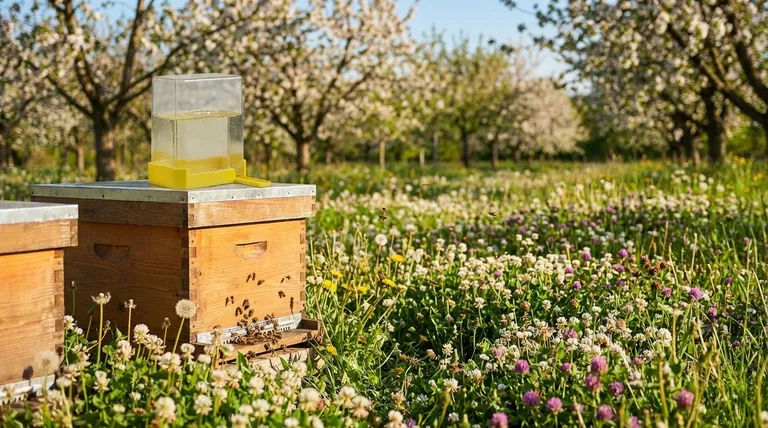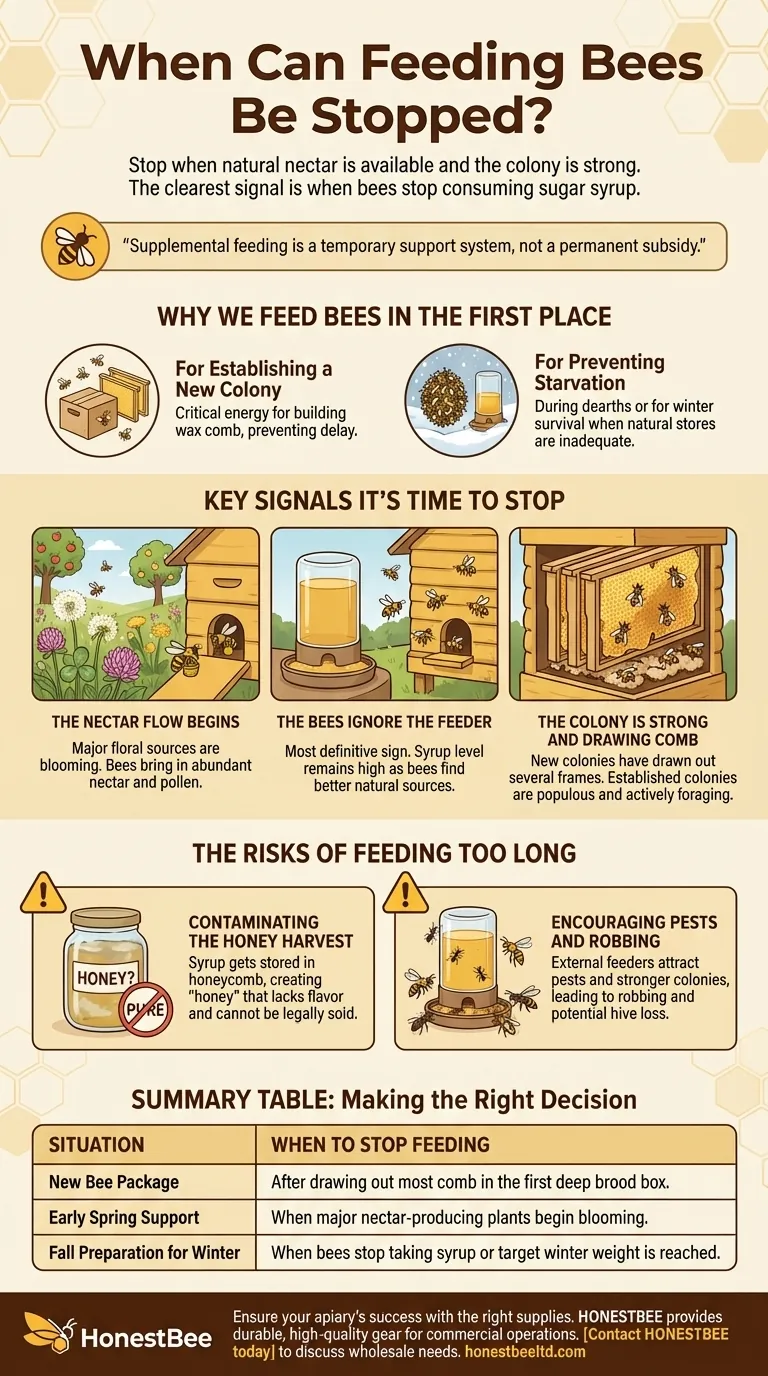In short, you should stop feeding bees when natural nectar sources become available and the colony is strong enough to forage for itself. The clearest signal is when the bees stop consuming the sugar syrup you provide, indicating they have found a better, natural food source.
Supplemental feeding is a temporary support system, not a permanent subsidy. Your primary goal is to use it strategically to ensure the colony's survival and growth, then remove it as soon as the bees can support themselves.

Why We Feed Bees in the First Place
Understanding why you started feeding is key to knowing when to stop. Supplemental feeding serves two primary purposes: establishment and survival.
For Establishing a New Colony
A new package or nucleus (nuc) of bees arrives with virtually no resources. They have no drawn comb, no stored honey, and no pollen reserves.
Feeding provides the critical energy they need to perform their most urgent task: building wax comb. Without this initial support, a new colony's development will be severely delayed.
For Preventing Starvation
Established colonies may require feeding during a "dearth"—a period when no natural nectar is available, often in late summer. It's also used in the fall to help bees build up sufficient honey stores to survive the winter if their own reserves are inadequate.
Key Signals It's Time to Stop
Your bees and the environment will give you clear signs that the feeder is no longer needed. Your job is to learn how to read them.
The Nectar Flow Begins
The "nectar flow" is the period when major floral sources are blooming and producing abundant nectar. This is the bees' preferred and most nutritious food source.
Once you see bees consistently returning to the hive with full pollen baskets and you observe major nectar sources (like clover, dandelions, or fruit trees) blooming in your area, it is time to stop feeding.
The Bees Ignore the Feeder
This is the most definitive sign. When a better option is available, bees will abandon the sugar syrup.
If you notice the syrup level in your feeder is not decreasing over several days, the bees are telling you they have found a superior natural source. Remove the feeder promptly.
The Colony Is Strong and Drawing Comb
For a new colony, a key milestone is the creation of drawn-out comb. Once the bees have built out several frames of comb in their first brood box and are actively foraging, you can begin to taper off and then stop feeding.
A strong colony with a healthy population and established comb can sustain itself during a good nectar flow.
The Risks of Feeding Too Long
Continuing to feed when it's not necessary can create significant problems for your hive and your honey harvest.
Contaminating the Honey Harvest
This is the most critical reason to stop feeding before you add honey supers. If you continue feeding while bees are storing nectar for honey, they will store the sugar syrup in the honeycomb.
This results in "honey" that is not made from nectar. It lacks the complex flavors and enzymes of real honey and cannot be legally or ethically sold or labeled as such.
Encouraging Pests and Robbing
An external feeder full of sugar syrup is a powerful attractant for ants, wasps, and bees from other hives.
This can lead to "robbing," where stronger colonies attack a weaker one to steal its resources, often resulting in the death of the weaker hive. Removing the feeder removes the temptation.
Making the Right Decision for Your Hive
Your approach to feeding should adapt to the specific situation and goal for your colony.
- If you have a new bee package: Feed continuously until the bees have drawn out most of the comb on the frames in their first deep brood box.
- If you are supporting an established hive in early spring: Stop feeding as soon as you see the first major nectar-producing plants begin to bloom in your area.
- If you are preparing a hive for winter: Feed heavy syrup in the fall only until the bees stop taking it or the hive has reached its target winter weight.
Ultimately, effective beekeeping is about observing your bees and their environment and responding to their needs.
Summary Table:
| Situation | When to Stop Feeding |
|---|---|
| New Bee Package | After drawing out most comb in the first deep brood box. |
| Early Spring Support | When major nectar-producing plants begin blooming. |
| Fall Preparation for Winter | When bees stop taking syrup or target winter weight is reached. |
Ensure your apiary's success with the right supplies.
Stop guessing when to feed your bees and focus on managing strong, productive colonies. HONESTBEE supplies commercial apiaries and beekeeping equipment distributors with the durable, high-quality gear needed for efficient large-scale operations—from hive components to protective clothing and harvesting tools.
Contact HONESTBEE today to discuss your wholesale supply needs and keep your colonies thriving.
Visual Guide

Related Products
- Professional Hive Front Entrance Bee Feeder
- Classic Boardman Entrance Bee Feeder Hive Front Feeding Solution
- Boardman Entrance Bee Feeder Durable Galvanized Steel and Wood Construction for Beekeeping
- HONESTBEE Entrance Bee Feeder Professional Hive Nutrition Solution for Beekeeping
- HONESTBEE Professional Hive Top Bee Feeder Feeding Solution
People Also Ask
- How is the mesh ladder and barrier installed in the feeder box? A Step-by-Step Guide to Prevent Bee Drowning
- What are entrance feeders, and where are they located? A Guide to External Hive Feeding
- Are entrance feeders good for bees? Prioritize Hive Health Over Convenience
- What is an entrance feeder and how is it used? Avoid the Critical Risk of Robbing
- How do you make an entrance feeder for bees? A Guide to Safe & Effective Hive Feeding



















